OFF-TOPIC (59)
By:
April 11, 2024
Off-Topic brings you over-the-transom, on-tangent essays, dialogues and subjective scholarship on an occasional, impulsive basis. For this mid-spring moment, a fleeting reflection on our many seasons of discontent…
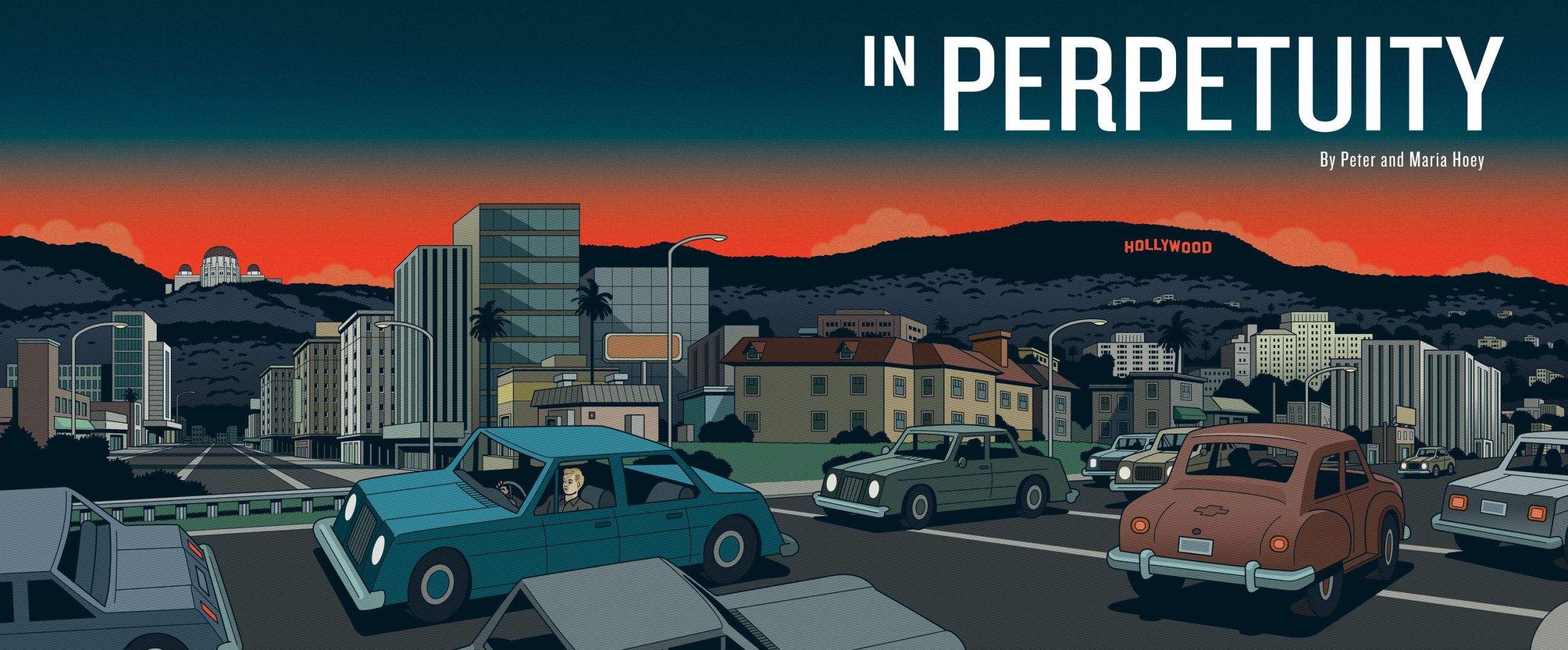
You can take a lot with you, and hell is holding on. In the mythology of the culture Western civilization sees itself as based on, the underworld was both the reserve of metals and minerals we wish for, and the repository of souls we miss. Its lord, Hades, was a covetous collector of the dead, but those in his kingdom were beyond wanting. Now we’ve become creatures of appetite, with expectations that are endless, and In Peter and Maria Hoey’s graphic novel
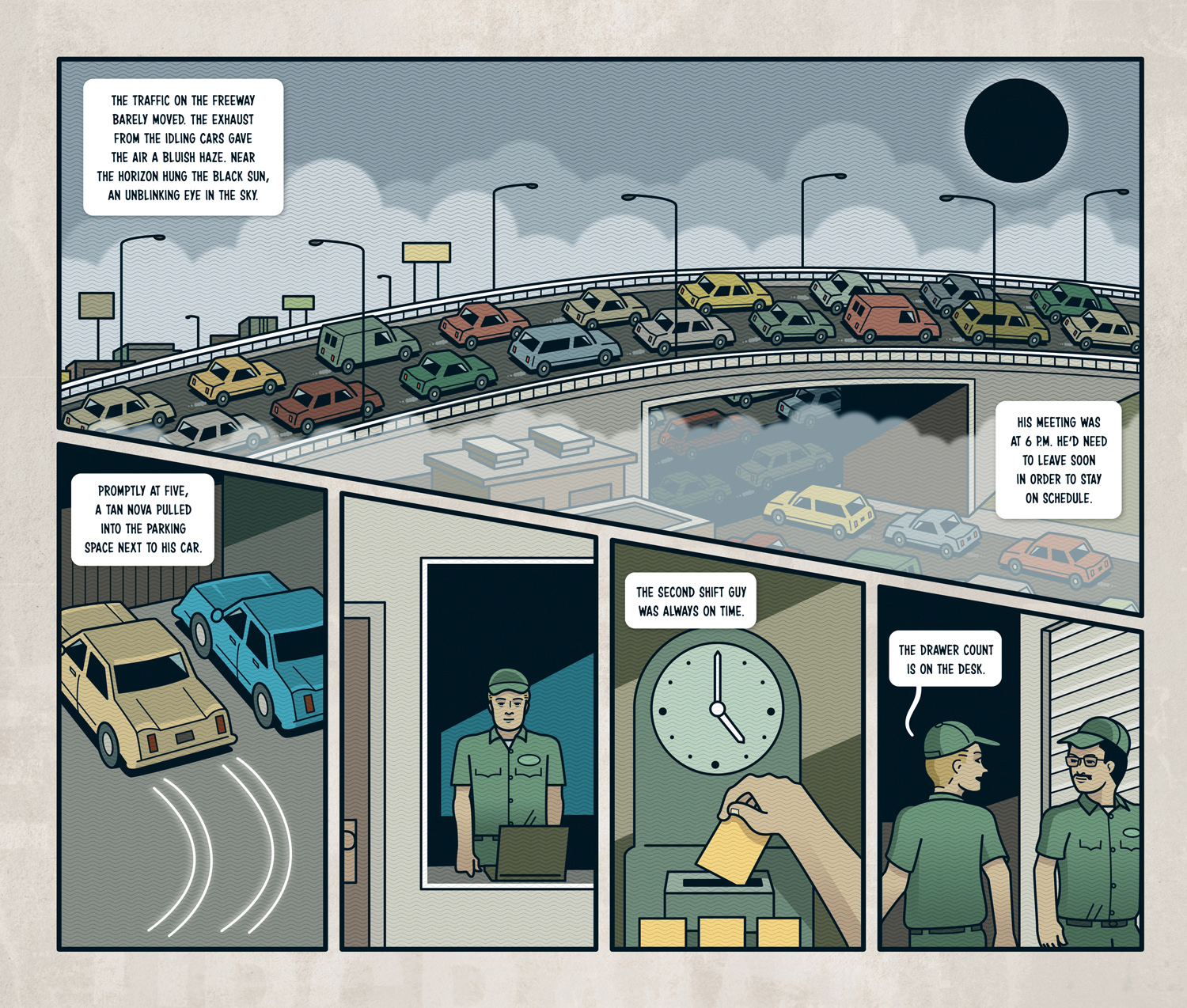
HILOBROW: We still tend to divide concepts of eternity into punishment and reward, whereas older conceptions like the Greek Hades and the Hebrew Sheol bypass the extremes of “heaven” and “hell” and just depict the afterlife as a kind of neutral, gray warehouse of souls. Blank is a very hard thing to draw — how were you able to approach it?
PETER: I looked at the Greek model of the afterlife: shades wandering forever in the Elysian fields. No sensual pleasures or pain, just a sort of anesthetized blankness. All of this pointed to a rootless sort of experience that might be found in Los Angeles. Since “no one walks in L.A.,” the shades would spend a lot of time driving aimlessly. At that point I figured there had to be some organizing principal of an economy. People would have jobs and apartments, but since it’s a city of the dead their main preoccupation is killing time.
HILOBROW: Your stories often take a cool detached method to portraying characters in various kinds of humorous chaos or existential crisis; here, you’ve crafted a story of grand sadness and desperate risk among characters who are largely incapable of affect and insulated from consequences…
PETER & MARIA: Our stories are told in a deadpan manner. We think this distancing makes the characters more interesting. They navigate the circumstances of their lives in a quiet, observant fashion.
PETER: I do think they are aware of the consequences they face, but they don’t reflect on it. They express themselves in actions rather than rumination.
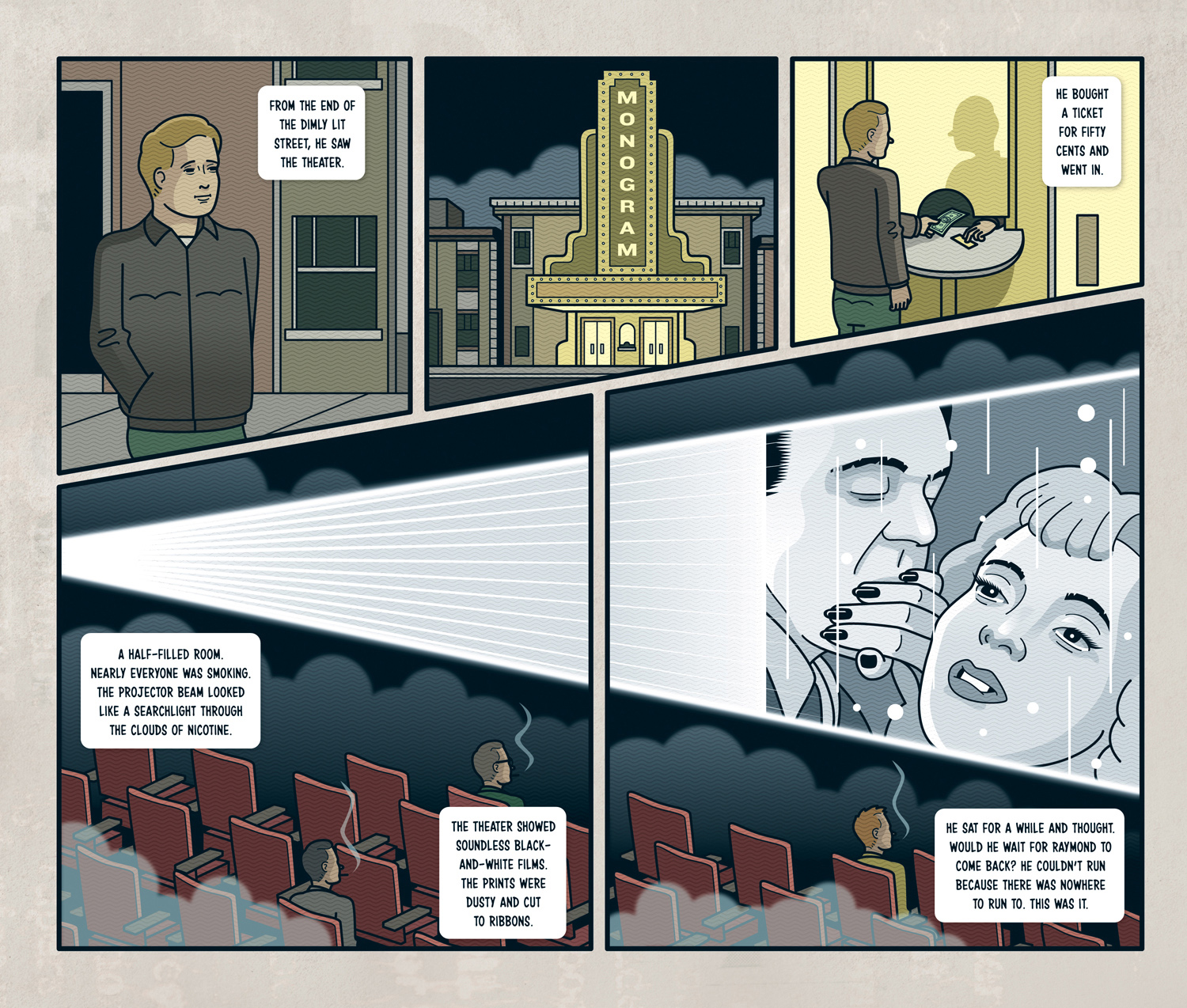
HILOBROW: The land of death we see in In Perpetuity seems also like a resting place for obsolete culture and stifling ways of life (from the retro tabletop-model feeling of the city to the ubiquitous smoking). Is nostalgia a form of death? Is looking back worse than death, even once you’re dead?
PETER & MARIA: The past is static. And if you’re living in the past, you have a world view that is walled off from the unpredictable expectations and outcomes of the future.
HILOBROW: L.A. is such a standard setting for noir — is it the barrenness, the feeling that humans don’t belong there, the movie/record-industry culture of sold souls? Could this story have been set anywhere else?
PETER & MARIA: Los Angeles is a city both real and imaginary. We took the imaginary Los Angeles and recast it as a necropolis. This story could only be set in that imaginary place.
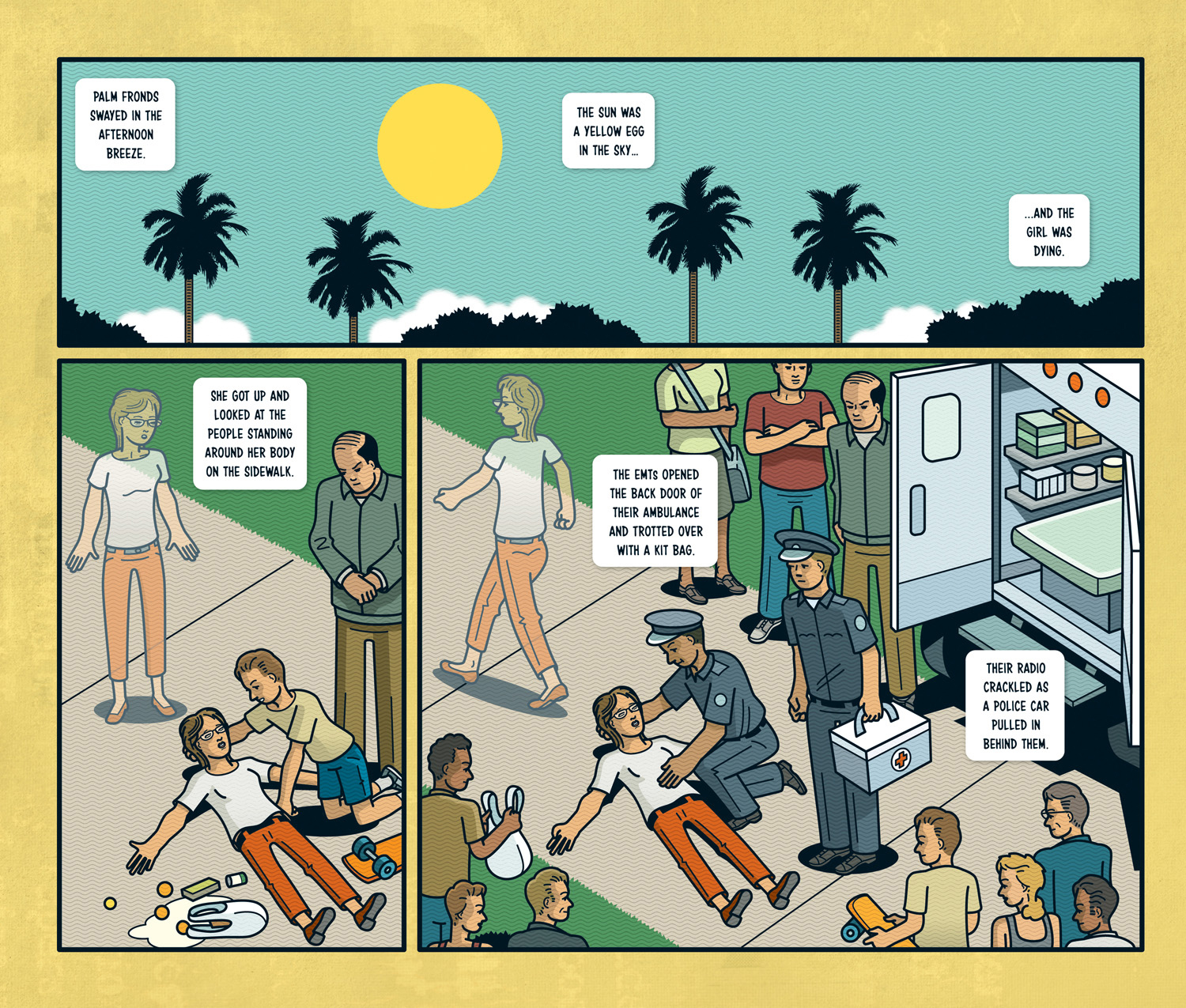
HILOBROW: It feels more than ever that the “cinematography” was central to this book — the solidity or transparency of people alive, dead and in-between, the glass panels and eerie glows, the major role of smoke and mist, the atmospheric palettes of eternal sunshine and gloom. To what extent was color and pattern a storytelling tool, and an inseparable ingredient?
PETER & MARIA: Color and balance was at the center of the story. As the plot moves from the A.L. to L.A. and back again, the reader needs to feel the change. We used shifting palettes to make the story clear and the contrast apparent.
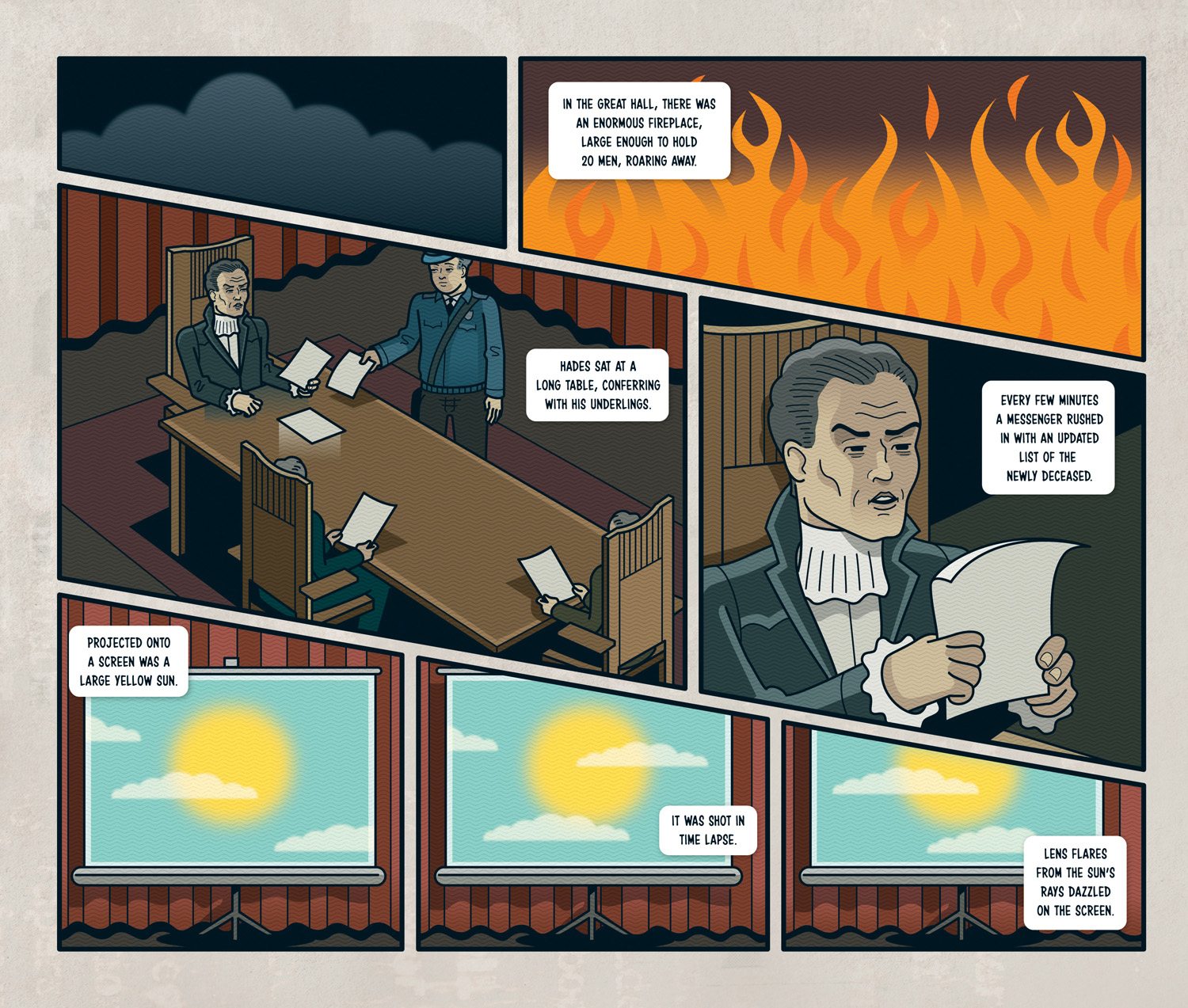
HILOBROW: The experience of this book is a liminal form of expression I didn’t know it was possible to get on paper. I’m fascinated to know what references fed into this, and what state of thought was needed to pursue and complete it.
PETER: I wanted the book to unfold in the deliberate manner of a dream. Using a deadpan voice casts a mesmeric tone to the story. Greek mythology, with its stories carefully balanced to offer multiple interpretations, was a big inspiration. I think this kind of storytelling had an influence in film noir. The unmooring pull of desire and the fatalistic view of death would have been familiar to the Greeks.
MORE POSTS by ADAM McGOVERN: OFF-TOPIC (2019–2024 monthly) | textshow (2018 quarterly) | PANEL ZERO (comics-related Q&As, 2018 monthly) | THIS: (2016–2017 weekly) | PEOPLE YOU MEET IN HELL, a 5-part series about characters in McGovern’s and Paolo Leandri’s comic Nightworld | Two IDORU JONES comics by McGovern and Paolo Leandri | BOWIEOLOGY: Celebrating 50 years of Bowie | ODD ABSURDUM: How Felix invented the 21st century self | KOJAK YOUR ENTHUSIASM: FAWLTY TOWERS | KICK YOUR ENTHUSIASM: JACKIE McGEE | NERD YOUR ENTHUSIASM: JOAN SEMMEL | SWERVE YOUR ENTHUSIASM: INTRO and THE LEON SUITES | FIVE-O YOUR ENTHUSIASM: JULIA | FERB YOUR ENTHUSIASM: KIMBA THE WHITE LION | CARBONA YOUR ENTHUSIASM: WASHINGTON BULLETS | KLAATU YOU: SILENT RUNNING | CONVOY YOUR ENTHUSIASM: QUINTET | TUBE YOUR ENTHUSIASM: HIGHWAY PATROL | #SQUADGOALS: KAMANDI’S FAMILY | QUIRK YOUR ENTHUSIASM: LUCKY NUMBER | CROM YOUR ENTHUSIASM: JIREL OF JOIRY | KERN YOUR ENTHUSIASM: Data 70 | HERC YOUR ENTHUSIASM: “Freedom” | KIRK YOUR ENTHUSIASM: Captain Camelot | KIRB YOUR ENTHUSIASM: Full Fathom Five | A 5-part series on Jack Kirby’s Fourth World mythos | Reviews of Annie Nocenti’s comics Katana, Catwoman, Klarion, and Green Arrow | The curated series FANCHILD | To see all of Adam’s posts, including HiLo Hero items on Lilli Carré, Judy Garland, Wally Wood, and others: CLICK HERE
